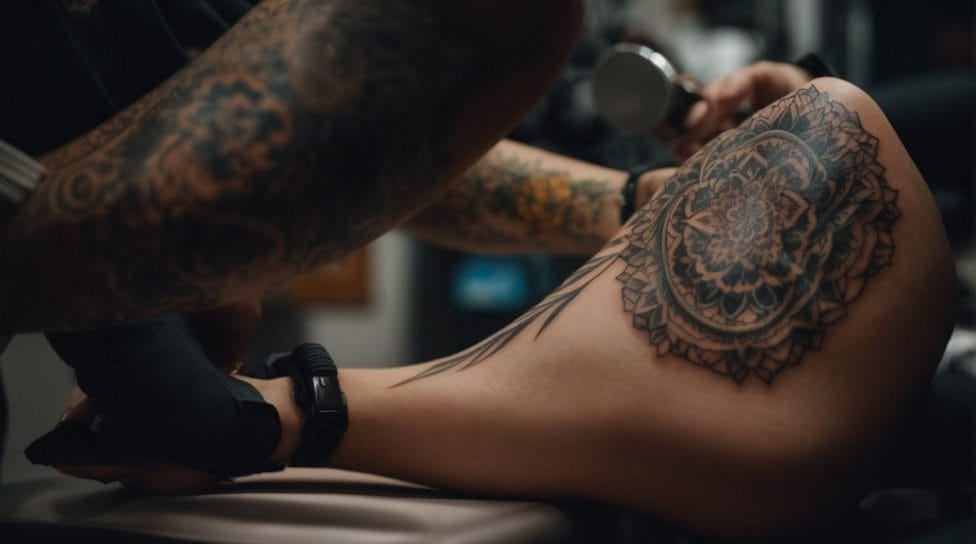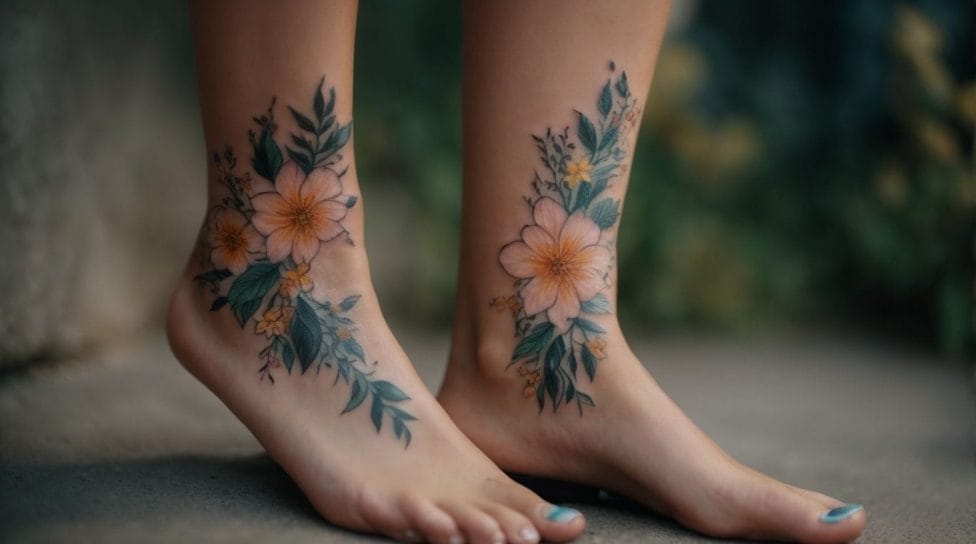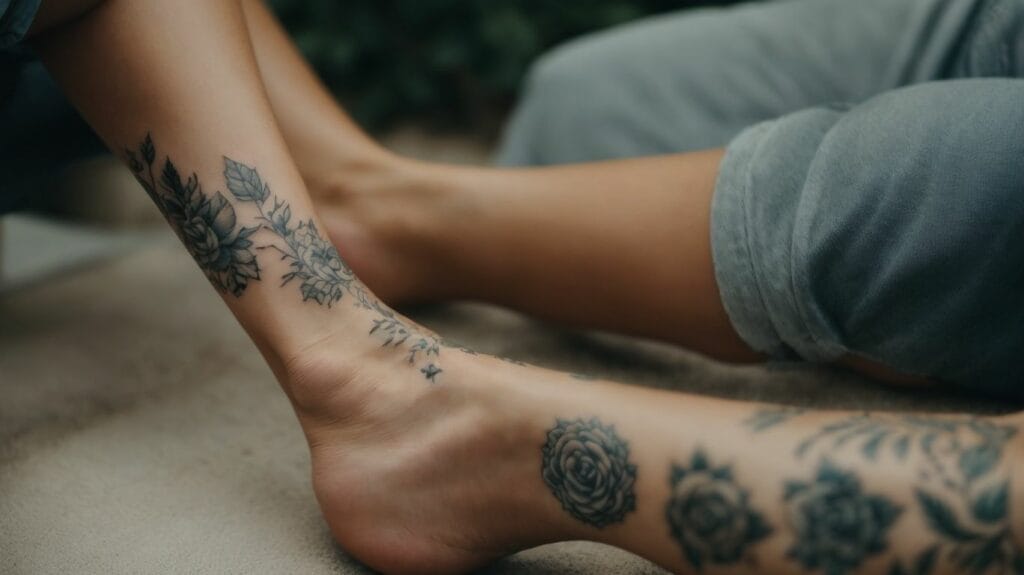When considering getting a tattoo, one of the common concerns is the level of pain involved in the process. Each body part has its sensitivity, and the ankle is no exception. Understanding the tattoo process and knowing what to expect can help alleviate any anxiety or apprehension about ankle tattoos.
Tattooing involves the use of a needle to insert ink into the skin, which naturally causes some amount of discomfort. The pain level experienced during a tattoo session can vary from person to person, with factors such as individual pain tolerance, the location of the tattoo, and the artist’s technique all playing a role.
While pain is subjective, many individuals find that getting an ankle tattoo can be more uncomfortable than other body parts. The skin around the ankle is relatively thin, with a higher concentration of nerve endings. This can result in a more intense sensation during the tattooing process.
However, it is important to note that pain tolerance varies from person to person. What may be painful for one individual may be more manageable for another. Factors such as the size and intricacy of the ankle tattoo can also influence the level of discomfort experienced.
Fortunately, several tips and techniques can help minimize pain while getting an ankle tattoo. Choosing an experienced and reputable tattoo artist, discussing placement and design considerations, and considering numbing agents or pain relief methods can all contribute to a more comfortable experience.
Aftercare for ankle tattoos is also crucial for minimizing discomfort during the healing process. Proper care, including cleaning the tattoo, applying recommended ointments, and avoiding certain activities, can help reduce pain, swelling, and potential infections.
By understanding the factors influencing tattoo pain, taking necessary precautions, and following proper aftercare, individuals can have a better understanding of what to expect when getting an ankle tattoo and take steps to minimize any potential discomfort.
Key takeaways:
- Ankle tattoos can be painful: The ankle is a sensitive area with thin skin and a high concentration of nerve endings, making getting an ankle tattoo more painful than other body parts.
- Pain tolerance varies: Individual pain tolerance differs, so the pain level experienced during an ankle tattoo will be subjective. Some people may find it more tolerable, while others may find it more painful.
- Tips to minimize pain: Choosing an experienced tattoo artist, considering placement and design, and using numbing agents can help minimize pain when getting an ankle tattoo.
Understanding the Tattoo Process

Photo Credits: Tattooineplanet.Com by Nathan Hill
Understanding the tattoo process is crucial before getting an ankle tattoo. Allow me to provide a step-by-step guide to help you grasp the process more effectively:
- First and foremost, select a reputable tattoo artist specializing in ankle tattoos.
- Consult with the artist to discuss your design ideas and determine the ideal placement on your ankle.
- Before the tattoo session, follow the artist’s instructions, which may include abstaining from alcohol and shaving the area.
- Once the session begins, the artist will cleanse the area, apply a stencil of the design, and commence tattooing using a needle and ink.
- Keep in mind that ankle tattoos can be more painful due to the thinness of the skin and their proximity to bones.
- Upon completion of the tattoo, the artist will provide aftercare instructions to ensure proper healing.
- It is vital to follow these instructions meticulously, including keeping the tattoo clean and well-moisturized, to prevent infection and facilitate healing.
- During the healing process, exercise patience, as ankle tattoos may take longer to heal than tattoos in other areas.
- Once your ankle tattoo is fully healed, you can enjoy its beautiful artistry to the fullest!
Why Do Tattoos Hurt?
Tattoos can be painful because the process involves repeatedly puncturing the skin with a needle, stimulating the nerve endings. The intensity of pain can vary depending on factors such as the individual’s pain tolerance, the location of the tattoo, and the size and complexity of the design. The body parts with thinner skin and closer proximity to bone tend to be more sensitive, like the ankle. Pain can be managed through various techniques, such as choosing an experienced tattoo artist, considering the design and placement, and using numbing agents. Understanding the reasons behind tattoo pain can help individuals prepare and cope with the discomfort.
In History, tattoos have been used for thousands of years across cultures, often serving as symbols of spirituality, status, or personal expression. T tattooing dates back to ancient civilizations, such as the Egyptians and Polynesians. In these cultures, tattoos were created using primitive tools and techniques that may have been more painful than modern methods. Despite the pain involved, tattoos continue to be popular today, with advancements in technology and techniques making the process more efficient and less painful. Tattoos have become a significant part of contemporary culture, representing individuality and creativity.
Factors Affecting Tattoo Pain
Various factors can affect the level of pain experienced during getting a tattoo, including Factors Affecting Tattoo Pain. These factors include the individual’s pain tolerance, the location of the tattoo on the body, the size and complexity of the design, and the skill level of the tattoo artist. Other Factors Affecting Tattoo Pain, such as the client’s hydration level, stress levels, and overall health, can also impact the pain experienced. It’s important to understand that pain is subjective and can vary from person to person. Taking these Factors Affecting Tattoo Pain into consideration can help individuals make informed decisions when getting a tattoo and manage their pain levels effectively.
Does Getting an Ankle Tattoo Hurt?

Photo Credits: Tattooineplanet.Com by Dennis Hill
Getting an ankle tattoo can be painful, but the pain level varies from person to person. Does getting an ankle tattoo hurt? The ankle has thin skin and is close to bone, making it a sensitive area. Pain tolerance, size, and tattoo design also play a role. Some people describe the pain as similar to a constant scratching or stinging sensation. To minimize discomfort, choose a professional and experienced tattoo artist, take breaks during the session if needed, and follow aftercare instructions carefully. Remember, pain is subjective, and everyone’s experience is different.
True story: I once got an ankle tattoo of a delicate flower. The pain was manageable, but the constant buzzing sensation was uncomfortable. The artist guided me through the process, and I took breaks when needed. Despite the mild pain, I’m happy with the final result. Does getting an ankle tattoo hurt?
Is Ankle Tattoo Pain Different from Other Body Parts?
Is ankle tattoo pain different from other body parts? Well, ankle tattoo pain can vary from getting a tattoo on other body parts due to several factors. The skin on the ankles, compared to areas like the arms or back, is thinner and has less fat and muscle. This difference can contribute to a more painful tattooing process on the ankle. Additionally, the ankle is a bony area with less cushioning, making it more sensitive. However, it is worth noting that the level of pain experienced during a tattoo can vary from person to person based on individual pain tolerance. That’s why it is important to communicate openly with your tattoo artist and discuss any concerns or questions about pain during the tattooing process.
How Do Ankle Tattoos Compare to Other Tattoo Locations in Terms of Pain?
Getting an ankle tattoo can be a painful experience, but it varies from person to person. Here are some key factors to consider when comparing ankle tattoos to other tattoo locations in terms of pain:
- Location: The ankle has less muscle and fat than other body parts, making tattooing more uncomfortable.
- Bony areas: The ankle has prominent bones that can cause additional discomfort during the tattooing process.
- Skin sensitivity: Some people may have more sensitive skin on their ankles, making the tattooing process more painful.
To compare ankle tattoos to other tattoo locations in terms of pain, one must consider the following factors:
- Location: Ankle tattoos are less comfortable due to the lower amount of muscle and fat in this area.
- Bony areas: Ankle tattoos can be more uncomfortable due to the presence of prominent bones in this region.
- Skin sensitivity: The skin on the ankles can be more sensitive in some individuals, which can increase the pain during the tattooing process.
To minimize the pain experienced during an ankle tattoo, it is important to:
- Choose an experienced tattoo artist who can efficiently work and minimize discomfort.
- Select a design and placement that takes into account the sensitive nature of the ankle.
- Consider using numbing agents or pain relief methods recommended by your artist.
Remember, pain tolerance is subjective, and everyone’s experience will vary. It’s essential to communicate with your tattoo artist and follow proper aftercare instructions to ensure a successful healing process.
Individual Pain Tolerance and Ankle Tattoos
Individual pain tolerance plays a significant role in how much discomfort one may experience when getting an ankle tattoo. Ankle tattoos can vary in terms of pain depending on an individual’s pain tolerance. Some people have a higher pain threshold and can handle the process with minimal discomfort, while others may find it more painful. It is important to remember that pain is subjective and varies from person to person, particularly regarding ankle tattoos. Factors such as the size and complexity of the design, as well as the skill of the tattoo artist, can also influence the level of pain experienced during an ankle tattoo session. Ultimately, it is essential to consider one’s pain tolerance when getting an ankle tattoo. Fact: Pain tolerance can be influenced by factors such as genetics, previous experiences, and overall physical and mental well-being.
Tips to Minimize Pain for Ankle Tattoos

Photo Credits: Tattooineplanet.Com by Steven Smith
Are you looking to get an ankle tattoo but worried about the pain? Here are some tips to minimize that discomfort. From choosing the right tattoo artist to considering the placement and design and even exploring numbing agents and pain relief methods, we’ve got you covered. Say goodbye to unnecessary suffering, and hello to a more pleasant tattoo experience! So, let’s dive into these essential tips and ensure your ankle tattoo journey is as pain-free as possible.
Choosing the Right Tattoo Artist
- When selecting the ideal tattoo artist for your ankle tattoo, it is important to consider the following steps:
- Examine their portfolio meticulously: Look closely at the artist’s previous work to ensure their style aligns perfectly with your vision.
- Review customer feedback: Check online platforms and social media for reviews from past clients to understand their professionalism and skills.
- Visit the studio: Take a trip to the tattoo parlor to evaluate cleanliness, organization, and the overall atmosphere.
- Schedule a consultation: Set up a meeting with the artist to discuss your ideas, ask questions, and get a sense of their communication style.
- Inquire about their experience: Ask about the artist’s experience in ankle tattoos to determine their expertise in this particular body part.
- Discuss pricing details: Understand the artist’s pricing structure and inquire about any potential additional costs that may arise.
- Trust your instincts: Ultimately, choose an artist who makes you feel comfortable, respected, and confident in your abilities.
Placement and Design Considerations
Regarding ankle tattoos, placement, and design considerations are of utmost importance in determining the overall outcome and experience. Here are some vital factors to take into account:
- Ankle shape: Incorporate the shape of your ankle to determine the most flattering placement for your tattoo.
- Size and detail: Since ankle tattoos are usually smaller due to limited space, opt for designs that are intricate yet legible.
- Visibility: Determine whether you prefer your tattoo to be easily visible or hidden, as this will affect the placement options.
- Pain tolerance: Remember that ankle tattoos can be more painful due to the thinner skin and proximity to bone.
- Footwear: Consider how your tattoo may interact with different types of shoes, especially if you have strict workplace dress codes.
Ankle tattoos have a rich history dating back to ancient civilizations like Egypt and Rome, where they were often associated with femininity, sensuality, and spirituality. Today, ankle tattoos are a popular choice for both men and women, symbolizing personal expression and individuality.
Numbing Agents and Pain Relief Methods
Using numbing agents and pain relief methods can greatly minimize discomfort when getting an ankle tattoo. Here are some options to consider:
- Topical creams: Before getting tattooed, apply an over-the-counter numbing cream that contains lidocaine or prilocaine to the ankle area.
- Ice or cold packs: Numb the area by placing ice or a cold pack on the ankle for a few minutes before starting the tattooing process.
- Pain relievers: To reduce pain and inflammation, it can be helpful to take over-the-counter pain relievers like ibuprofen or acetaminophen before the session.
True story: A friend of mine utilized a numbing cream before getting an ankle tattoo and reported significant pain reduction during the process. As a result, she could comfortably sit through the session and was pleased with the outcome.
Aftercare for Ankle Tattoos

Photo Credits: Tattooineplanet.Com by Joseph Rivera
Taking care of your ankle tattoo is crucial to ensure proper healing and minimize discomfort. In this section, we’ll explore effective methods for caring for your ankle tattoo, including tips to minimize pain and swelling post-tattoo session. Discover the essential aftercare practices that will help keep your ankle tattoo looking vibrant and prevent potential complications. Let’s dive into the world of ankle tattoo aftercare and ensure your new ink heals beautifully.
Taking Care of Your Ankle Tattoo to Minimize Discomfort
Taking care of your ankle tattoo properly can help minimize discomfort and promote healing. Here are some steps to follow:
- Minimize discomfort by caring for your ankle tattoo: Gently wash the tattooed area with mild soap and lukewarm water, pat it dry with a clean towel, and avoid soaking it in water.
- Promote healing by applying a thin layer of ointment: Use a recommended ointment or a fragrance-free moisturizer to prevent drying and promote healing. Remember to avoid excessive application.
- Prevent rubbing and irritation on the tattooed area: Opt for loose-fitting clothes and open-toed shoes to avoid tight clothing and footwear that may cause discomfort and irritation.
- Protect your ankle tattoo from sun exposure and fading: Avoid direct sunlight and tanning beds to prevent fading colors and discomfort.
- Avoid damaging the healing process: Refrain from scratching or picking at the tattooed area, as it can lead to infection and hinder the healing process.
- Promote healing with good hydration and a balanced diet: Stay hydrated and eat a balanced diet to support overall skin health and aid in the healing process.
By following these steps, you can minimize discomfort and ensure the best possible healing for your ankle tattoo. Remember, if you experience excessive pain, swelling, or signs of infection, consult a professional tattoo artist or a healthcare provider.
Dealing with Pain and Swelling After Getting an Ankle Tattoo
After getting an ankle tattoo, it’s common to experience pain and swelling. Here are some steps to help deal with pain and swelling after getting an ankle tattoo:
- Apply a cold compress: Use an ice pack or a bag of frozen peas wrapped in a clean cloth to reduce swelling and numb the area.
- Elevate your leg: Keeping your ankle above your heart level can help reduce swelling.
- Take over-the-counter pain relievers: Nonsteroidal anti-inflammatory drugs (NSAIDs) like ibuprofen can help alleviate pain and reduce inflammation.
- Keep the area clean and moisturized: Follow proper aftercare instructions from your tattoo artist to prevent infection and promote healing.
- Avoid tight or restrictive clothing: Opt for loose-fitting clothing and avoid shoes or socks that pressure the tattooed area.
1. How long does the pain last after getting an ankle tattoo?
After getting an ankle tattoo, the pain typically lasts for about one to two weeks.
“How long does the pain last after getting an ankle tattoo?” is a common question many individuals ask before getting an ankle tattoo. It is important to note that the pain associated with an ankle tattoo usually subsides within one to two weeks. This duration may vary depending on individual pain tolerance and the size and complexity of the tattoo.
The intensity of the pain may vary depending on individual pain tolerance and the size and complexity of the tattoo.
When it comes to the intensity of pain experienced, it is subjective and can differ from person to person. Factors such as individual pain tolerance and the size and complexity of the ankle tattoo play a significant role. Some individuals may experience more intense pain, while others may find it more tolerable.
It is common to experience discomfort, swelling, and tenderness during the healing process.
During the healing process of an ankle tattoo, it is common to encounter discomfort, swelling, and tenderness. These are natural responses of the body as it works to repair the skin and integrate the ink. However, it is important to remember that these discomforts are temporary and should gradually subside over time.
To minimize pain and promote healing, follow proper aftercare techniques such as keeping the tattoo clean, avoiding excessive movement, and applying prescribed ointments.
To facilitate the healing process and alleviate pain, it is crucial to adhere to appropriate aftercare techniques. These techniques include keeping the ankle tattoo clean by gently washing it with mild soap and water, avoiding excessive movement that might strain the area, and applying the ointments prescribed by your tattoo artist or medical professional. Consistent and proper aftercare significantly contribute to pain reduction and the overall healing of the ankle tattoo.
If the pain persists or worsens after a couple of weeks, consult your tattoo artist or a medical professional.
If the pain persists or worsens beyond the expected timeframe of one to two weeks, it is advisable to seek advice from your tattoo artist or consult a medical professional. They can assess the situation and provide appropriate guidance or medication to alleviate prolonged discomfort.
Remember, pain is subjective, and everyone’s experience may differ.
Lastly, it is crucial to remember that pain is subjective and can vary greatly from person to person. Each individual’s pain tolerance and sensitivity differ, meaning that a shared experience of pain can be unique in its manifestation and duration. So, it’s essential not to compare your pain with others and instead focus on proper aftercare to ensure a successful healing process.
2. Are ankle tattoos more painful to remove compared to other areas?
Ankle tattoos can indeed be more painful to remove compared to tattoos in other areas of the body. The skin on the ankle is naturally thinner, and there is less padding, which increases its sensitivity to the removal process. Moreover, the ankle is a high-movement area, which poses challenges and potentially escalates the pain during the tattoo removal. It is crucial to consult with a professional tattoo removal specialist to discuss the specifics of your ankle tattoo and determine the most suitable and least painful removal method.
3. Can I wear shoes or socks immediately after getting an ankle tattoo?
After getting an ankle tattoo, it is important to take care and avoid any activities or clothing that could irritate the tattooed area. Here are some steps to follow:
- Give it time: Allow the tattoo to fully heal before wearing shoes or socks, which could rub against the sensitive skin and hinder the healing process.
- Opt for open-toed shoes: If possible, wear sandals or flip-flops to avoid direct contact with the tattooed area.
- Loose-fitting socks: If wearing socks is necessary, choose loose-fitting ones made of breathable material to minimize friction and irritation.
- Protective barrier: Apply a thin layer of ointment or a tattoo aftercare product to create a protective barrier between the tattoo and your footwear.
- Follow aftercare instructions: Continue to follow the aftercare instructions provided by your tattoo artist to ensure proper healing.
True story: After getting a fresh ankle tattoo, Sarah decided to wear socks immediately, thinking it wouldn’t affect the healing process. Unfortunately, the friction caused the tattoo to become irritated, leading to prolonged healing and less vibrant colors. Sarah learned the importance of giving her ankle tattoo time to heal and avoiding tight-fitting clothing.
Can I wear shoes or socks immediately after getting an ankle tattoo?
After getting an ankle tattoo, it is essential to let it heal properly and avoid any actions or garments that may irritate the tattooed area. To ensure a successful healing process, here are a few recommendations:
- Be patient and give it time: It is crucial to give the tattoo enough time to fully heal before putting on shoes or socks. Wearing them immediately can result in rubbing against the sensitive skin, hindering the healing process.
- Try open-toed shoes: Whenever possible, wearing sandals or flip-flops instead of closed shoes provides a great way to avoid direct contact with the tattooed area.
- Choose loose-fitting socks: In case wearing socks becomes necessary, it is advisable to opt for breathable socks that are loose-fitting. This helps minimize friction and irritation.
- Apply a protective barrier: To safeguard the tattoo and your footwear, apply a thin layer of ointment or a tattoo aftercare product.
- Follow aftercare instructions: It is important to adhere to the aftercare instructions provided by your tattoo artist to ensure proper healing of the ankle tattoo.
True story: Sarah had a recent experience of getting an ankle tattoo and then wearing socks immediately without considering the healing process. Sadly, this resulted in friction and irritation, leading to prolonged healing time and less vibrant colors. Sarah now understands the significance of allowing her ankle tattoo to heal properly and avoiding tight-fitting clothing.
Some Facts About Do Ankle Tattoos Hurt?
- ✅ Ankle tattoos can be more uncomfortable due to the thinner skin in that area. (Source: readinsideout.com)
- ✅ The outside of the ankle, closer to the ankle bone, tends to be more sensitive and prone to discomfort. (Source: readinsideout.com)
- ✅ The inside of the ankle is generally less painful than the outside. (Source: readinsideout.com)
- ✅ The front and back of the ankle, often bent and rubbed, can be more tender and sensitive. (Source: readinsideout.com)
- ✅ The style and complexity of the tattoo design can influence the level of pain experienced during the process. (Source: readinsideout.com)


